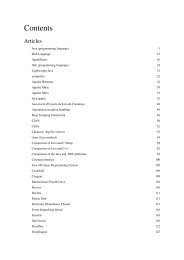Essentials of Javascript - Cultural View
Essentials of Javascript - Cultural View
Essentials of Javascript - Cultural View
Create successful ePaper yourself
Turn your PDF publications into a flip-book with our unique Google optimized e-Paper software.
JavaScript syntax 29<br />
my_array=my_string.match(my_expression);<br />
// example<br />
my_array="We start at 11:30, 12:15 and 16:45".match(/\d\d:\d\d/); //<br />
my_array=("11:30","12:15","16:45");<br />
Capturing groups<br />
var myRe = /(\d{4}-\d{2}-\d{2}) (\d{2}:\d{2}:\d{2})/;<br />
var results = myRe.exec("The date and time are 2009-09-08 09:37:08.");<br />
if(results) {<br />
alert("Matched: " + results[0]); // Entire match<br />
var my_date = results[1]; // First group == "2009-09-08"<br />
var my_time = results[2]; // Second group == "09:37:08"<br />
alert("It is " + my_time + " on " + my_date);<br />
} else alert("Did not find a valid date!");<br />
Function<br />
Every function in <strong>Javascript</strong> is an instance <strong>of</strong> the Function object:<br />
var add=new Function('x','y','return x+y');//x,y is the<br />
argument.'return x+y' is the function body, which is the last in the<br />
argument list.<br />
var t=add(1,2);<br />
alert(t);//3<br />
The add function above is <strong>of</strong>ten defined using the following pattern, as this pattern is faster and more intuitive.<br />
function add(x,y)<br />
{<br />
}<br />
return x+y;<br />
var t=add(1,2);<br />
alert(t);//3<br />
A function instance has properties and methods.<br />
function subtract(x,y)<br />
{<br />
}<br />
return x-y;<br />
alert(subtract.length);//2,expected amount <strong>of</strong> arguments.<br />
alert(subtract.toString());<br />
/*<br />
function subtract(x,y)<br />
{<br />
}<br />
*/<br />
return x-y;










